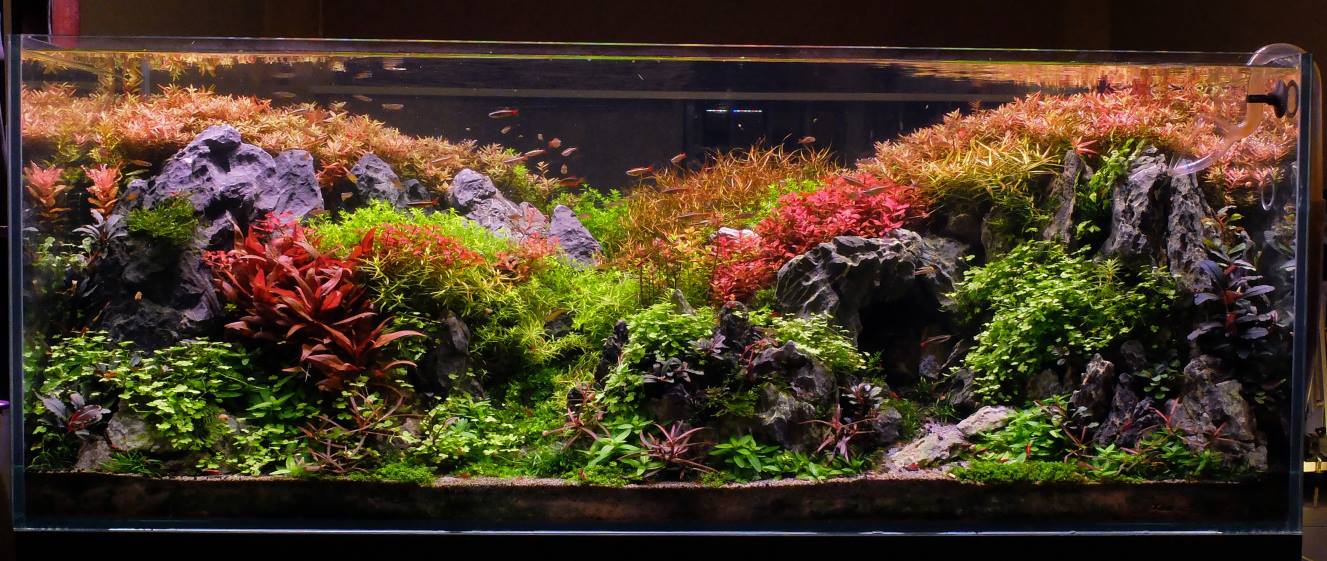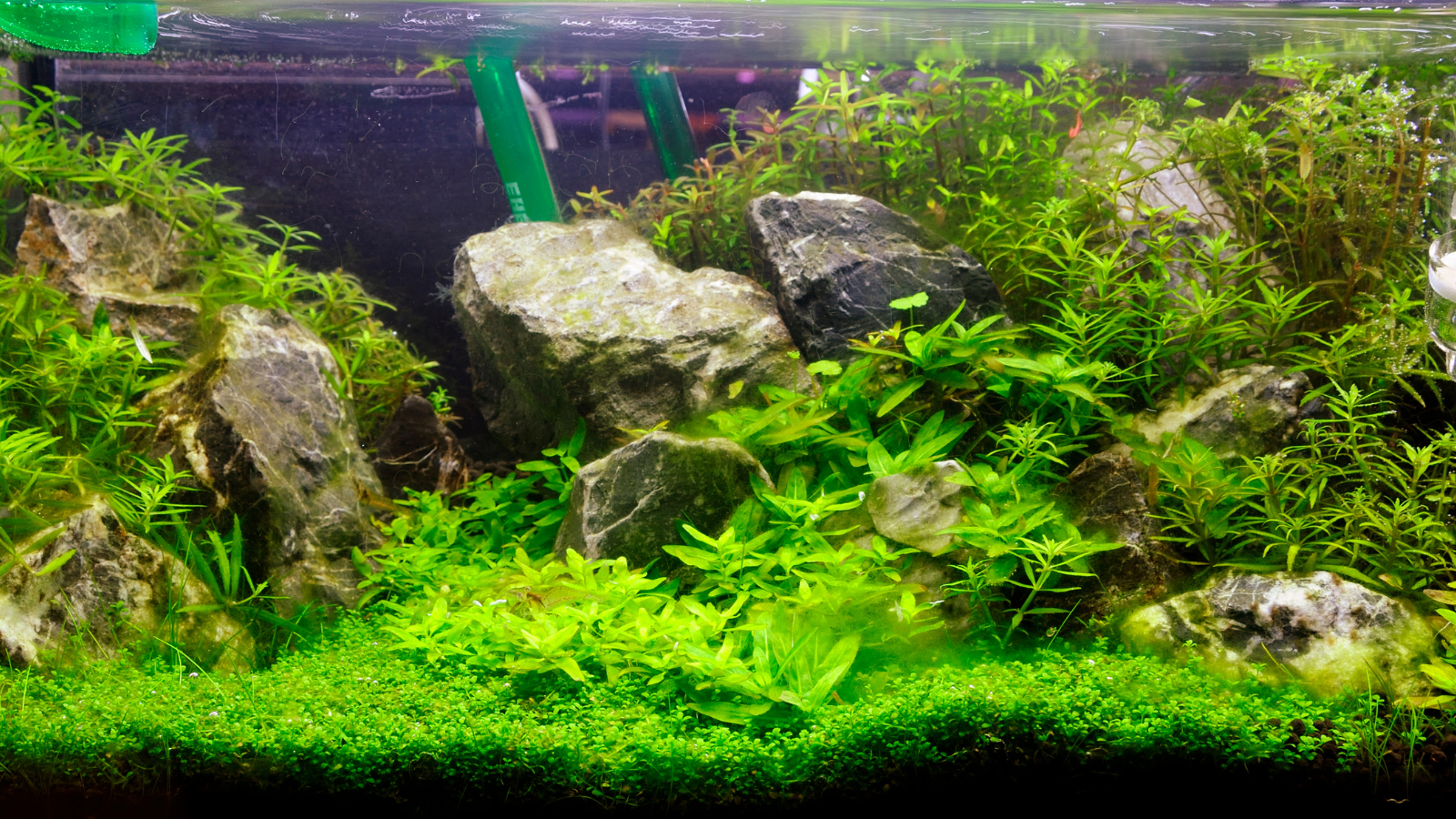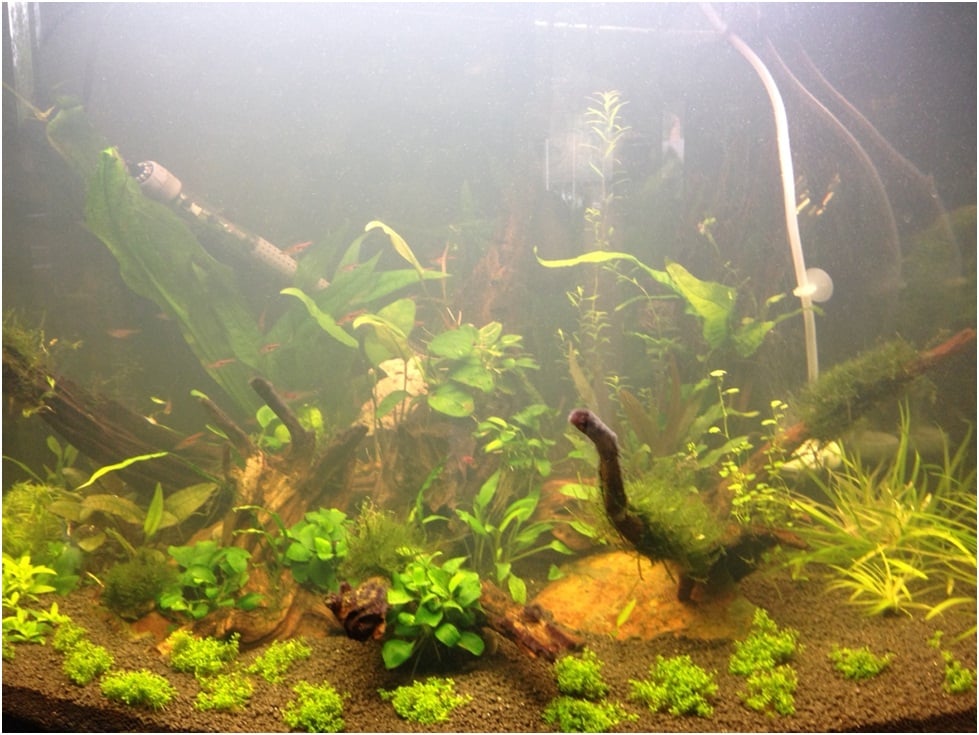Aquascaping - Arranging rocks and wood and plants in a way that is purposeful and pleasing to the eye


For most of us, our first experience with live aquatic plants often includes sturdy plant species such as Anubias, Amazon Swords and Vallisneria. For many years, aquarists have created healthy looking planted tanks with lower levels of light and the correct balance of micro nutrients. This is ideal for plants that don’t require a lot of energy to grow. With the correct level of maintenance and understanding of the plants needs in terms of nutrients you really can create and maintain lush green underwater gardens.
With the introduction of high powered LED lights it is now possible to grow delicate brightly coloured plants that were unimaginable all those years ago. The Alternanthera reineckii Mini with its bright red leaves and compact bushy appearance means it is often used to create lush thick carpets across the substrate. Growing a plant like this can be tricky. Light needs to penetrate deep enough to reach the leaves which is why we see so many auqascapers are using LED lights.
When you provide your aquatic plants with stronger lights, you do need to take into account that this extra light speeds up the process called photosynthesis. Our aquatic plants use the light you provide to convert carbon dioxide into a sugary carbohydrate energy source which allows them to grow. So to grow these aquatic plants it is necessary to provide them with the best possible environment. When this balance of light, carbon dioxide and nutrients is met, the perfect environment is created, the results are beautiful.
When we first began to grow aquatic plants, many of us would construct our own reactors using sugar, yeast and water. This is still a popular method of supplying less demanding aquarium plants with CO2 in smaller aquariums.
For larger aquariums with high powered LED lights it is pressurised CO2 injection that provides aquascapers with a accurate and reliable source of CO2. Using the correct equipment allows the aquascaper to provide the exact amount of CO2 for their plants to insure the create the perfect environment for both plants and fish. High pressured CO2 injection is made up of four things.
CO2 Regulator
 Injecting CO2 into your aquarium must be controlled. Too little and it will have no effect and too much can have a devastating effect on your aquarium inhabitants. In order to achieve a steady and reliable supply of CO2 for your aquarium plants, we use the regulators. This vital piece of equipment attaches to the CO2 cylinder and allows the aquascaper to set the rate of CO2 as it travels to the aquarium. Without the regulator, pressurised CO2 cannot be provided.
Injecting CO2 into your aquarium must be controlled. Too little and it will have no effect and too much can have a devastating effect on your aquarium inhabitants. In order to achieve a steady and reliable supply of CO2 for your aquarium plants, we use the regulators. This vital piece of equipment attaches to the CO2 cylinder and allows the aquascaper to set the rate of CO2 as it travels to the aquarium. Without the regulator, pressurised CO2 cannot be provided.
Selecting a regulator with a solenoid attached allows even more control over the supply of CO2. The solenoid gives the aquascaper the capacity to set a run time for the regulator by attaching to a common socket timer. By setting the regulator to begin operating 1 hour before the aquarium lights switch on will insure a good build up of CO2 in the aquarium as soon as the lights come on. The photosynthesis process can only happen when the lights are on therefor CO2 must be switched off about 1 hour before the lights switch off. By creating this on/off period, you are offering your plants the maximum supply for the optimum period of the day. This also acts as a safety measure to ensure your aquarium inhabitants are not at risk of too much unused CO2 in the aquarium.
Bubble Counter

The role of this simple attachment is to indicate the speed of the CO2 as it travels via the regulator up to the aquarium. Bubble counters allow the aquascaper to visually estimate the rate by counting the bubbles. By partially filling the chamber with water, the co2 travels through and creates bubbles. The more bubbles, the more co2.
CO2 Diffuser

In order to break down the CO2 and allow it to be absorbed successfully, we need to use an adequate diffuser. Depending on the aquarium setup and the aquascapers choice, the diffuser can be either inside the aquarium or connected to an external filter outside the aquarium. The CO2, after leaving the regulator and traveling via the bubble counter enters the diffuser and then passes through the porous element and is transformed into tiny bubbles. These tiny bubbles are released into the aquarium and in turn is absorbed by the aquarium plants.
Drop Checker

To maintain an effective level of CO2 while insuring the safety of your aquarium inhabitants its important to be able to know that you are not only injecting the correct amount, but also that it is being dissolved effectively and being distributed efficiently too. A simple way to do this is to install a drop checker inside the aquarium at the opposite side to the diffuser. This will measure the level of dissolved co2 in the water. The way these little contraptions work is rather clever. They are designed in a way that once you add the indicator solution and add the drop check to the aquarium, there is a small area of trapped air between the aquarium water and the indicator solution. Within this space, co2 escapes the aquarium water and travels towards the indicator solution chamber. This CO2 begins to interact with the solution and will change colour depending on the level of CO2 present. Within two hours you can normally confirm if your co2 levels are efficient enough to grow plants while remaining at a safe level for your aquarium inhabitants. A green coloured solution means you have reached the most effective level of CO2 while a blue solution shows a lack of CO2 present and a yellow solution indication too much CO2 is present.
Taking time to understand the importance of carbon dioxide in a plants life cycle is important but when it comes to aquascaping, it is only one part of the puzzle. Knowing what your aquarium plants require to grow is one thing, knowing how they grow and feed is something that we must also understand. Researching each individual plant and their needs is just as important as researching the needs of your aquarium inhabitants too.
We have bushy plants, tall plants, short plants and everything in between. Some plants love to be rooted in a nutrient rich substrate while others prefer to be attached to rocks or wood. Knowing these details plays just as much a part in your success as providing the perfect balance of light and CO2.
In the past such knowledge was rare. Only the most dedicated members of the aquarist society would have the lushest aquariums. Nowadays the modern aquarist or ‘aquascaper’ is somewhat spoiled by the integration of aquaria and the internet. We can just type the name of a plant into any search engine and we are presented with care sheets and plant profiles in abundance. Todays aquascaper has everything they need to create the perfect underwater work of art - all that limits them is your own creativity.


